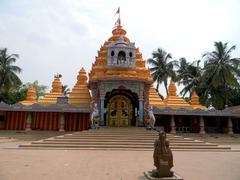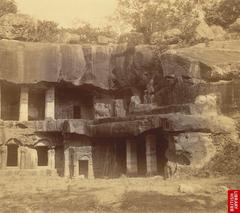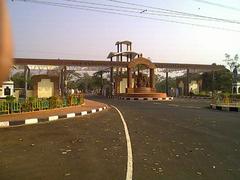Devasabha Temple: Visiting Hours, Tickets, and Bhubaneswar Historical Sites Guide
Date: 04/07/2025
Introduction
Nestled in the heart of Bhubaneswar’s Old Town, the Devasabha Temple is an understated gem within Odisha’s renowned “City of Temples.” Dating back to the 14th century and situated within the Kharakhia Vaidyanath temple precinct, Devasabha Temple stands as a testament to the enduring legacy of medieval Kalinga architecture and the region’s spiritual syncretism. Though currently abandoned and devoid of active worship, its elegant Rekha Deul spire, intricate stonework, and tranquil ambiance invite visitors to explore Bhubaneswar’s layered heritage. This guide provides comprehensive information on Devasabha Temple’s history, architectural features, religious significance, visiting details, responsible tourism, and nearby attractions.
Table of Contents
- Introduction
- Historical Background
- Architectural Features
- Religious and Cultural Significance
- Visitor Information
- Responsible Tourism and Preservation
- Nearby Attractions
- Frequently Asked Questions (FAQ)
- Visual and Travel Resources
- Summary and Recommendations
- Sources and Further Reading
Historical Background
Origins and Construction
Devasabha Temple, meaning “Assembly of the Gods,” was constructed during the later medieval period (14th century), continuing Bhubaneswar’s legacy as a city of temple-building excellence. Unlike most temples dedicated to a specific deity, Devasabha was conceived as a communal space representing the collective divine, reflecting the region’s inclusive religious ethos (Indianetzone). Despite periods of neglect and the absence of ongoing worship, the temple remains a significant symbol of Bhubaneswar’s spiritual and cultural landscape.
Architectural Features
The temple exemplifies the Rekha Deul style of Kalinga architecture. Set upon a low, square platform (about 5.5 sq. meters, 0.6 meters high), the structure features a square sanctum with 4-meter sides and a modest porch. Its pancharatha plan includes a central raha flanked by anuratha and kanika pagas. The tower (vimana) rises 5.73 meters, with a fivefold panchanga bada base. In contrast with other Bhubaneswar temples, Devasabha’s gandi and mastaka are relatively austere, lacking elaborate carvings yet retaining symbolic gravitas (Indianetzone).
Religious and Cultural Significance
Inclusive Spirituality
Devasabha Temple’s identity as a congregation space for all deities sets it apart from the city’s more famous, deity-specific temples such as Lingaraj (Lord Shiva) or Ananta Basudeva (Lord Krishna). This inclusive tradition aligns with Odisha’s historical syncretism, where Hinduism, Buddhism, and Jainism have mutually influenced religious practices and temple designs (Tripcrafters). Today, the temple’s abandoned state invites contemplation on the evolution of regional devotional practices.
Visitor Information
Location and Access
The temple is located in the southwest corner of the Kharakhia Vaidyanath complex, Old Town Bhubaneswar. It is easily accessible by auto-rickshaw, taxi, or local bus and is within walking distance of major landmarks like Lingaraj Temple and Bindu Sagar (Indianetzone).
Visiting Hours
- Open daily: Sunrise to sunset (approximately 6:00 AM–6:00 PM)
- No fixed hours or restrictions due to its abandoned state
Entry Fees
- Free entry: No tickets required.
Accessibility
- The temple stands on a low platform with steps; wheelchair access is limited.
- The terrain may be uneven—sturdy footwear is recommended.
Photography and Etiquette
- Photography is allowed; be respectful and seek permission if caretakers or locals are present.
- Modest attire is advised, and shoes should be removed before entering the platform.
Facilities
- No restrooms or refreshments on site; eateries are available nearby in Old Town Bhubaneswar.
- Carry water and basic necessities, especially during summer or monsoon months.
Best Time to Visit
- October to February: Cooler, more comfortable weather (7–25°C).
- Avoid peak summer (March–June) and heavy monsoon (July–September).
Responsible Tourism and Preservation
- Respect the monument: Do not touch or climb on the temple structure; avoid damaging carvings.
- Keep the site clean: Carry out any litter; avoid single-use plastics.
- Support the community: Hire local guides for heritage walks, and purchase from nearby vendors.
- Cultural sensitivity: Maintain quiet and reverence; participate respectfully in local festivals.
- Conservation awareness: Report vandalism; share positive, preservation-focused stories on social media.
Nearby Attractions
Devasabha Temple is ideally situated for inclusion in a Bhubaneswar temple circuit. Notable sites nearby include:
- Lingaraj Temple: The city’s grandest and most revered Shaivite temple (WanderOn).
- Mukteshwar Temple: Known for its exquisite torana and detailed carvings (Stamped Moments).
- Rajarani Temple: Famous for red/yellow sandstone and unique sculptures.
- Ananta Basudev Temple: Significant Vaishnava site with a community kitchen.
- Bindu Sagar: Sacred tank—ideal for a peaceful walk and reflection.
- Odisha State Museum: Offers broader context on regional history and art.
Frequently Asked Questions (FAQ)
Q: What are the visiting hours of Devasabha Temple?
A: Sunrise to sunset, typically 6:00 AM–6:00 PM.
Q: Is there an entry fee?
A: No, visiting is free.
Q: How do I get there?
A: Old Town Bhubaneswar—accessible by auto-rickshaw, taxi, or local bus. Walking distance from Lingaraj Temple.
Q: Is the temple wheelchair accessible?
A: Limited; there are steps and uneven terrain.
Q: Are guided tours available?
A: No official tours, but local guides can be hired for heritage walks.
Q: Can I take photographs?
A: Yes, photography is generally allowed—be respectful and seek permission if necessary.
Visual and Travel Resources
- Seek high-quality images of Devasabha Temple’s Rekha Deul spire, detailed stonework, and tranquil setting.
- Use interactive maps for Bhubaneswar’s temple precincts.
- Consider virtual tours or video guides where available for enhanced planning.
Summary and Visitor Recommendations
The Devasabha Temple offers a tranquil, reflective experience amid Bhubaneswar’s vibrant historical sites. Its distinct Rekha Deul architecture, unique role as a congregation space, and accessible location make it a rewarding stop for travelers seeking a deeper understanding of Odisha’s religious and cultural heritage. Visitors are encouraged to explore responsibly, respect local customs, and enhance their visit with nearby attractions and local heritage walks. For the most comfortable experience, visit during the cooler months and consider combining your trip with major temple festivals for cultural immersion.
Stay updated and get personalized travel guides by downloading the Audiala app, and follow related Bhubaneswar temple resources for ongoing insights.
Sources and Further Reading
- Devasabha Temple Bhubaneswar: History, Visiting Hours & Ticket Information, 2024, Capture a Trip
- Devasabha Temple Bhubaneswar: Visiting Hours, Tickets & Architectural Guide, 2024, Temple Yatri
- Devasabha Temple Bhubaneswar: Visiting Hours, History, Architecture, and Nearby Attractions, 2024, Indianetzone
- Tripcrafters: Bhubaneswar Tourism and Travel Guide
- WanderOn: Places to Visit in Bhubaneswar
- Stamped Moments: Bhubaneswar Travel Guide








